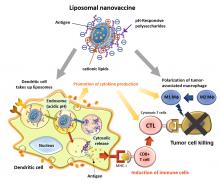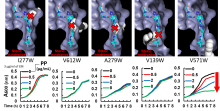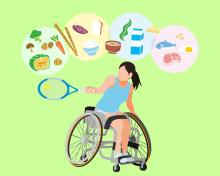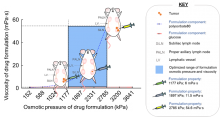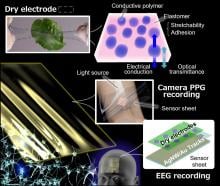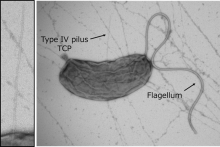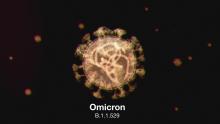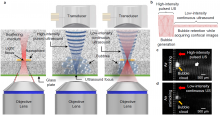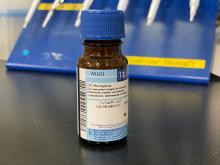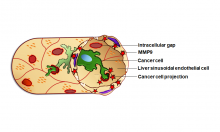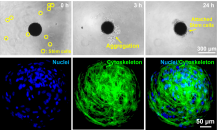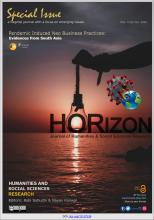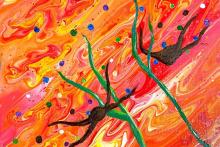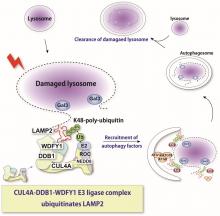Medicine & Healthcare
News
01 Nov 2022
Triple-negative breast cancer (TNBC) tumors gain immunosuppression and chemoresistance through interactions between interleukin 34 and myeloid-derived suppressor cells, researchers find.
31 Oct 2022
While both protect from severe disease, inactivated SARS-CoV-2 and spike mRNA vaccines trigger different T-cell responses.
31 Oct 2022
Call To Action urges G20 member countries and partners to mobilize adequate resources to close the TB funding gap and save lives.
31 Oct 2022
A research group at Osaka Metropolitan University has developed a drug delivery system that activates a strong cellular immune response to attack cancer cells, using one-tenth of the amount of antigen needed in the group’s previous work. By incorporating positively charged cationic lipids into liposomes and adding negatively charged pH-responsive polysaccharides to the surface, the research group increased the uptake efficiency of liposomes encapsulating cancer antigens by dendritic cells by approximately five times, which increased cytokine production by about 100 times. This increased M1-type macrophages, which activate cancer immunity, and decreased M2-type macrophages, which promote cancer growth.
31 Oct 2022
Researchers from Osaka University used a combination of genetic manipulation and protein structural analysis to determine how the position of “bulky” amino acids influences the ability of efflux pump inhibitors to bind bacterial pump proteins and so reduce their resistance to antibiotics. This work has implications for our understanding of bacterial antibiotic resistance, and may be useful in the rational design of drugs that target bacteria that have evolved antibiotic resistance.
26 Oct 2022
Leading global scientists and policymakers will exchange learnings to promote multi-sectoral
collaboration to address complex global health challenges
25 Oct 2022
Research led by the School of Chinese Medicine at Hong Kong Baptist University (HKBU) has identified cryptotanshinone, a compound extracted from the Chinese herbal medicine Salvia miltiorrhiza, with the potential for the treatment and prevention of gastric cancer associated with bile reflux. The researchers unveiled the mechanism of how bile reflux induces gastritis and gastric cancer. They explained that refluxed bile acids (BAs) lead to the proliferation of pro-inflammation bacteria that promote gastric carcinogenesis, the formation of cancer.
25 Oct 2022
Small neighboring galaxy filled with dark matter detected with gamma rays, How a virus induces heart inflammation, Shedding light on the happy hormone, Microfossils may hold key evolution clues. Read all in the October's Editor's Choice plus Upcoming event KNOWLEDGE MARKETPLACE – Bangkok 2022: Exchanging of ideas for a Democratic Myanmar.

24 Oct 2022
Investigations in Japan have uncovered some molecular mechanisms behind mitochondrial dysfunction in chronic heart failure.
20 Oct 2022
Osaka Metropolitan University researchers interviewed active para-athletes with lower-limb disabilities who compete at an international level, about diet and nutrition. The research team found that what para-athletes considered an ideal diet was not necessarily optimized for improving athletic performance, and even when para-athletes understood diets geared towards athletic performance, characteristics of their disabilities impose barriers to implementing dietary changes. Understanding these concerns and struggles is important for nutritionists who support para-athletes in sports nutrition.
19 Oct 2022
Osaka Metropolitan University researchers conducted a study of human mobility to find effective lifestyle changes that enable people to exist with the novel coronavirus COVID-19, while maintaining social and economic activities. They found that restricting the human mobility in specific areas according to the state of the pandemic, rather than uniformly controlling human mobility, could be effective in reducing the number of new COVID-19 infections.
19 Oct 2022
When a cancer spreads, the invasion of tumor cells into the lymph nodes present various barriers to effective treatment. Harnessing a lymphatic drug delivery system, where drugs are injected directly into sentinel lymph nodes under ultrasound guidance, a collaborative research group has developed a novel drug formulation that enhances the therapeutic response of carboplatin, a commonly used chemotherapy medication.
17 Oct 2022
Researchers from Osaka University have developed a skin-like device to measure brain activity via electroencephalography, which uses electrodes to measure electrical activity on the scalp (reflecting underlying brain activity). The device has other useful applications, such as measuring heart rate and blood oxygen levels. Wearable devices that can remotely assess brain health in everyday settings are likely to improve healthcare for millions of people worldwide.
17 Oct 2022
Researchers from Osaka University have shown that deficiency of the protein Favine can lead to accelerated development of atherosclerosis. Loss of Favine in a mouse atherosclerosis model also led to calcification and thrombus development in the blood vessels of the mice. Prior to this, no mouse models for calcification or thrombus formation existed, hindering atherosclerosis research. This work also identifies Favine and its downstream signaling pathway, known as MEF2C-KLF2, as potential therapeutic targets for atherosclerosis.
17 Oct 2022
The Malaysia Technology Expo (MTE) 2022: SDG International Innovation Awards & Expo (SDGIIAE) returns for its 2nd edition and the awards encourage the development of innovative solutions for local and global challenges.
14 Oct 2022
Researchers from Osaka University have found that the Vibrio cholerae colonization factor TcpF forms a flower-shaped trimer to specifically bind to the minor pilus protein TcpB resulting in secretion by the type 4 pilus secretion system into the extracellular space. This finding could help lead to the development of a novel anti-adhesive drug that selectively interrupts the TcpF-TcpB interaction, which may replace antibiotics in the treatment of cholera.
12 Oct 2022
A study in Japan finds antibody response to the Moderna COVID-19 mRNA vaccine does not vary depending on the time of day when the dose was received.
10 Oct 2022
The SARS-CoV-2 Omicron variant escapes the immune response better than its coronavirus ancestors, but has also facilitated our transition to a society that can live with COVID-19.
07 Oct 2022
- DGIST Professor Jin Ho Chang and Jae Youn Hwang's joint research team revealed for the first time in the world that the depth focused light can be increased by using a bubble layer temporarily created using ultrasound.
- The collaborative research of ultrasound and optical imaging experts is expected to overcome the physical limitations of optical imaging and treatment depth.
06 Oct 2022
Researchers from Osaka University have found that serum albumin interferes with β2m amyloid fibril formation through macromolecular crowding. Monitoring serum albumin concentrations could therefore help prevent patients from developing dialysis-related amyloidosis, a serious complication of long-term dialysis.
06 Oct 2022
Low concentrations of cetylpyridinium chloride, an antimicrobial agent present in mouthwashes, inhibit the infectivity of four variants of SARS-CoV-2.
04 Oct 2022
Metastasis—when cancer spreads to form new tumors—causes approximately 90% of cancer-related deaths. Because metastatic cancer cells circulate in the blood, the liver—which filters the blood—is considered the most vulnerable organ, so treatments that prevent liver metastasis are urgently needed. A team of Osaka Metropolitan University researchers discovered a mechanism that allows metastatic cancer cells to infiltrate the liver, and how that infiltration can be blocked by inhibiting a related protein.
29 Sep 2022
A simple and economical method of detecting SARS-CoV-2 viral loads in wastewater with high sensitivity has been developed, expanding the use of wastewater-based epidemiology for tracking the virus in populations.
29 Sep 2022
Linked lanthanides shine light on crystal engineering, New technique reveals hidden genome, Red, white and blue alerts for dangerous bacteria & Windows gain competitive edge over global warming. Read all in the September's Editor's Choice plus this month's Asia Research News 2022 magazine pick - Floating sensors to gather ocean data.
27 Sep 2022
-Microrobots disintegrate in the body after delivering stem cells to the target point, and the delivered stem cells are verified to be capable of normal proliferation and differentiation.
-Expected to contribute to increasing the efficiency of regenerative medicine such as stem cell delivery.
23 Sep 2022
A special issue of Horizon Journal of Humanities & Social Sciences Research (JHSSR Vol.4 (S) Oct. 20212) is now published. This issue includes papers on the Covid-19 pandemic, developments in business and digital practices, changes in social media behavior in South Asia.
22 Sep 2022
Researchers led by Osaka University developed a novel fluorescent sensor to detect and monitor levels of the neuropeptide oxytocin, also known as the “happy hormone.” The OT sensor facilitated the successful measurement of OT dynamics in the brains of living animals and may serve as a foundation for the development of therapeutics for the treatment of neurological disorders such as autism and schizophrenia.
20 Sep 2022
A research group led by the Institute of Industrial Science, The University of Tokyo, finds that sensory neurons in human skin modulate melanocytes via the secretion of Repulsive Guidance Molecule B
16 Sep 2022
Osaka University researchers identified the specific protein complex that recognizes when cellular organelles called lysosomes become damaged. When this occurs, the CUL4A protein complex transfers a molecular tag, called polyubiquitin, to a lysosomal protein known as LAMP2. WDFY1, another protein in the complex, is able to recognize and interact with LAMP2. These initial steps are critical to beginning a process called lysophagy, in which these damaged lysosomes are cleared away by the cell.
Events
Sorry, nothing coming up for this discipline
- « first
- ‹ previous
- 1
- 2
- 3
Researchers
Sorry, nothing coming up for this discipline
- « first
- ‹ previous
- 1
- 2
- 3
Giants in history
Sorry, nothing coming up for this discipline





